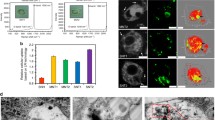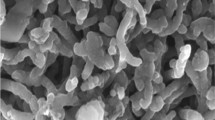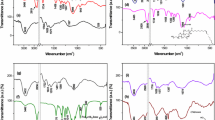Abstract
Polycitric acid was conjugated onto the surface of carbon nanotubes (CNTs), and hybrid nanomaterials containing CNT axis and polycitric acid branches that were highly soluble in aqueous solutions were synthesized. In this work, pristine MWCNTs were opened and functionalized through treatment with acid, then polycitric acid was covalently grafted onto their surface by the “grafting from” approach based on polycondensation of citric acid in the melting state. The chemical structure, morphology, thermal properties and size of MWCNT-g-PCA hybrid materials were investigated by IR, 13C NMR, 1H NMR, TEM, TGA, DSC and DLS. To investigate the biocompatibility of the synthesized hybrid nanomaterials and their potential applications for future nanomedicine, short-term in vitro cytotoxicity and hemocompatibility tests were conducted on HT1080 cell line (human fibrosarcoma). Based on the results of the in vitro cytotoxicity tests and hemolysis assay, no adverse effect was observed on the HT1080 cell and also on red blood cells up to 1 mg/mL concentration. It appeared that the changes in the conformation, shape and dispersity of CNTs, induced by the conjugated hyperbranched polymers, were the main factors that affected the toxicity of CNTs and also their interaction with the cell membranes. Interestingly, the results of the cytotoxicity tests were in agreement with our previous work, carbon nanotubes-graft-polyglycerol, proving that hyperbranched polymers conjugated onto the surface of CNTs dominated their physiochemical properties and therefore their interactions with the cell membranes.










Similar content being viewed by others
References
Adeli M, Soleyman R, Beiranvand Z, Madani F (2013) Carbon nanotubes in cancer therapy: a more precise look at the role of carbon nanotubes–polymer interactions. Chem Soc Rev 42:5231–5256
Yarotski DA, Kilina SV, Talin AA, Tretiak S, Prezhdo OV, Balatsky AV, Taylor AJ (2009) Scanning tunneling microscopy of DNA-wrapped carbon nanotubes. Nano Lett 9:12–17
Lacerda L, Raffa S, Prato M, Bianco A, Kostarelos K (2007) Cell-penetrating CNTs for delivery of therapeutics. Nano Today 2:38–43
Lam CW, James JT, McCluskey R, Arepalli S, Hunter RL (2006) A review of carbon nanotube toxicity and assessment of potential occupational and environmental health risks. Crit Rev Toxicol 36:189–217
Ding L, Stilwell J, Zhang T, Elboudwarej O, Jiang H, Selegue JP, Cooke PA, Gray JW, Chen FF (2005) Molecular characterization of the cytotoxic mechanism of multiwall carbon nanotubes and nano-onions on human skin fibroblast. Nano Lett 5:2448–2464
Adeli M, Hakimpoor F, Ashiri M, Kabiri R, Bavadi M (2011) Anticancer drug delivery systems based on noncovalent interactions between carbon nanotubes and linear-dendritic copolymers. Soft Matter 7:4062–4070
Adeli M, Mirab N, Alavidjeh MS, Sobhani Z, Atyabi F (2009) Carbon nanotubes-graft-polyglycerol: biocompatible hybrid materials for nanomedicine. Polymer 50:3528–3536
Mehdipoor E, Adeli M, Bavadi M, Sasanpour P, Rashidian B (2011) A possible anticancer drug delivery system based on carbon nanotube–dendrimer hybrid nanomaterials. J Mater Chem 21:15456–15463
Qiao R, Ke PC (2006) Lipid-carbon nanotube self-assembly in aqueous solution. J Am Chem Soc 128:13656–13657
Baskaran D, Mays JW, Bratcher MS (2004) Polymer-grafted multiwalled carbon nanotubes through surface-initiated polymerization. Angew Chem Int Ed 43:2138–2142
Namazi H, Adeli M (2003) Novel linear–globular thermoreversible hydrogel ABA type copolymers from dendritic citric acid as the A blocks and poly(ethyleneglycol) as the B block. Eur Polym J 39:1491–1500
Namazi H, Adeli M (2005) Dendrimers of citric acid and poly(ethylene glycol) as the new drug-delivery agents. Biomaterials 26:1175–1183
Naeini AT, Adeli M, Vossoughi M (2010) Poly(citric acid)-block-poly(ethylene glycol) copolymers—new biocompatible hybrid materials for nanomedicine. Nanomed Nanotechnol Biol Med 6:556–562
Qian X, Peng X-H, Ansari DO, Yin-Goen Q, Chen GZ, Shin DM, Yang L, Young AN, Wang MD, Nie S (2008) In vivo tumor targeting and spectroscopic detection with surface-enhanced Raman nanoparticle tags. Nat Biotechnol 26:83–90
Li X, Liu H, Niu X, Yu B, Fan Y, Feng Q, Cui F-Z, Watari F (2012) The use of carbon nanotubes to induce osteogenic differentiation of human adipose-derived MSCs in vitro and ectopic bone formation in vivo. Biomaterials 33:4818–4827
Cui D, Tian F, Ozkan CS, Wang M, Gao H (2005) Effect of single wall carbon nanotubes on human HEK293 cells. J Toxicol Lett 155:73–85
Kostarelos K (2008) The long and short of carbon nanotube toxicity. Nat Biotechnol 26:774–776
Poland CA, Duffin R, Kinloch I, Maynard A, Wallace WA, Seaton A, Stone V, Brown S, Macnee W, Donaldson K (2008) Carbon nanotubes introduced into the abdominal cavity of mice show asbestos-like pathogenicity in a pilot study. Nat Nanotechnol 3:423–428
Schipper ML, Nakayama-Ratchford N, Davis CR, Kam NWS, Chu P, Liu Z, Sun X, Dai H, Gambhir SS (2008) A pilot toxicology study of single-walled carbon nanotubes in a small sample of mice. Nat Nanotechnol 3:216–221
Adeli M, Beyranvand S, Kabiri R (2013) Preparation of hybrid nanomaterials by supramolecular interactions between dendritic polymers and carbon nanotubes. Polym Chem 4:669–674
Adeli M, Beyranvand S, Hamid M (2012) Noncovalent interactions between linear-dendritic copolymers and carbon nanotubes; a promising way to avoid the asbestos-like pathology of long carbon nanotubes. J Mater Chem 22:6947–6952
Acknowledgments
The authors would like to thank the Iran National Science Foundation, INSF, for the financial support this work.
Author information
Authors and Affiliations
Corresponding author
Rights and permissions
About this article
Cite this article
Adeli, M., Alavidjeh, M.S. & Mohammadifar, E. Cytotoxicity of carbon nanotube/polycitric acid hybrid nanomaterials. Iran Polym J 23, 195–201 (2014). https://doi.org/10.1007/s13726-013-0215-6
Received:
Accepted:
Published:
Issue Date:
DOI: https://doi.org/10.1007/s13726-013-0215-6




